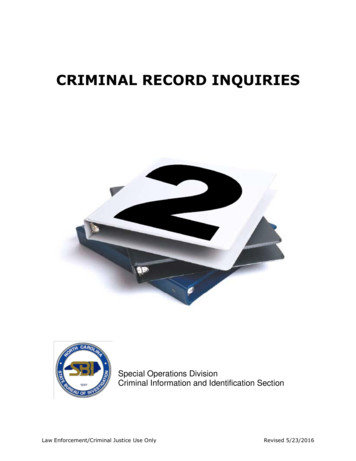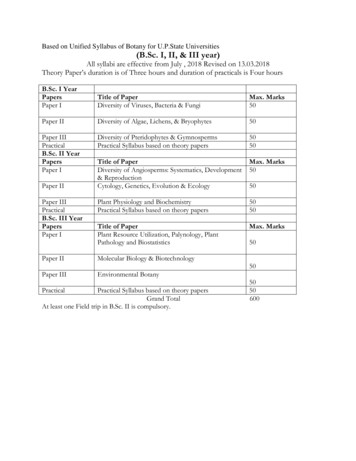Irish Immigration Lesson Plan Revised TOedits
Irish Immigration Lesson PlanCentral Historical Question:Were the Irish considered “white” in the 19th century?Materials: Copies of Documents A-D Copies of Guiding Questions Copies of Graphic OrganizerNote: The main goal of this lesson is for students to recognize that racial categorieshave changed over time. Students should discover that the Irish were not consideredwhite for most of the 19th century. At the end of the lesson (not before!) you may want toexplain that the Irish, in fact, occupied a place of racial ambiguity in America for most ofthe 19th century.Plan of Instruction:1. Introduction: Brief lecture on Irish immigration:o Long history of oppression by the British.o Arrived in the U.S. in the 1840s because of the potato famine.o Mostly settled in cities, worked in factories.o Extremely poor.o Anti-Irish sentiment was really high for a number of reasons: Irish were poor and slums developed in cities; people blamed theIrish for crime, disease, prostitution, alcohol abuse, etc. Irish were Catholic; most Americans were Protestant and claimedCatholics could not be trusted because they would be more loyal tothe Pope than to the U.S. government (to this day, the U.S. hasonly had one Catholic president).o Know-Nothing Party was strongly anti-Irish and anti-immigrant.2. Introduce activity: In groups of 4, you will receive 4 pieces of evidence. Answer thequestions about each piece of evidence and then decide, as a group:Were the Irish considered “white” in 19th-century America?3. Discussion: Were the Irish considered “white” in the 19th century? What does it mean to be white?What evidence supports the argument that they were considered white? Whatevidence supports the argument that they were not considered white?STANFORD HISTORY EDUCATION GROUPsheg.stanford.edu
Citations:Thomas Nast, Cartoon, Harper’s Weekly, December 7, 1876.“Irish Declaration of Independence,” Puck, May 9, 1883.http://www.hsp.org/default.aspx?id 394The Know-Nothing and American Crusader, July 29, 1854.http://hsp.org/sites/default/files/legacy files/migrated/anticatholicpress.pdfDavid R. Roediger, Wages of Whiteness, 1991, p. 146.http://books.google.com/books?id PwyMmV1 0kMC Copyright 2009, Avishag Reisman and Bradley Fogo.STANFORD HISTORY EDUCATION GROUPsheg.stanford.edu
Document A: Thomas Nast Cartoon, 1876This cartoon by Thomas Nast was published on December 7, 1876, inHarper’s Weekly.STANFORD HISTORY EDUCATION GROUPsheg.stanford.edu
Document B: Know-Nothing NewspaperThis is an excerpt from an article that appeared in a Boston newspaper,The Know-Nothing and American Crusader.THINGS WHICH ROMAN CATHOLIC PRIESTS AND ALL TRUE ROMANCATHOLICS HATEProvidence, July 22, 18541. They HATE our Republic, and are trying to overthrow it.2. They HATE our Flag, and they grossly insulting it.3. They HATE the liberty of the Press.4. They HATE the liberty of speech.5. They HATE our Public School system.6. They HATE the Bible, and would blot it out of existence if they could!7. They HATE Protestants, and are sworn to exterminate them from ourcountry and the earth.8. They HATE all rulers that do not swear allegiance to the Pope of Rome.9. They HATE to be ruled by Americans, and say “WE WILL NOT BERULED BY THEM!”10. They HATE to support their own paupers and they are left to besupported by the tax paying Americans.11. They HATE, above all, the “Know-Nothings,” who are determined to ridthis country from their cursed power.—UNCLE SAMSTANFORD HISTORY EDUCATION GROUPsheg.stanford.edu
Document C: Historian accountThis is an excerpt from historian David Roediger’s book Wages ofWhiteness.Irish-Americans workers . . . [were sometimes] used as substitutes forslaves within the South. Gangs of Irish immigrants worked ditching anddraining plantations, building levees and sometimes clearing land becauseof the danger of death to valuable slave property (and, as one account putit, to mules) in such pursuits . . . One Southerner explained the use of Irishlabor on the grounds that: “n-----s are worth too much to be risked here; ifthe Paddies (Irish) are knocked overboard . . . nobody loses anything.”Irish youths were also likely to be found in the depleted ranks of indenturedservants from the early national period (early 1800s) through the Civil War.In that position they were sometimes called “Irish slaves” and morefrequently “bound boys.” . . . In New York City, Irish women comprised thelargest group of prostitutes, or as they were sometimes called in the 1850s,“white slaves.”Source: David R. Roediger, Wages of Whiteness, 1991.STANFORD HISTORY EDUCATION GROUPsheg.stanford.edu
Document D: CartoonThis cartoon by Frederick Burr Opper was published in the magazine Puckin 1883. It shows a non-Irish woman imploring her Irish cook to continueher duties. The cook shakes her fist in defiance.Cartoon text: The Irish declaration of independence that we are all familiar with.STANFORD HISTORY EDUCATION GROUPsheg.stanford.edu
Name:Guiding QuestionsDocument A1. (Close reading) The man on the right is supposed to be Irish. What comparison is thecartoon making?2. (Close reading) What is the message of this cartoon?Document B1. (Close reading) Based on this document, what were three reasons the Know-Nothingstargeted Irish Catholics?2. (Close reading) Based on this document, what are two reasons why the Know-Nothingsbelieved being Catholic was incompatible with being a United States citizen?Document C1. (Contextualization) Why were Irish used for difficult labor in the South?2. (Close reading) Based on this document, how were the Irish treated?Document D1. (Close reading) The woman on the right is supposed to be Irish. Describe what she looks likeand how she’s acting. Based on this document, what were some stereotypes about Irishwomen?2. (Contextualization) Based on this document, what job do you think many Irish women had inthe 1880s?STANFORD HISTORY EDUCATION GROUPsheg.stanford.edu
Were the Irish considered white in 19th centuryAmerica?Evidence that the Irish wereconsidered whiteEvidence that the Irish were NOTconsidered whiteFinal conclusion: Were the Irish considered white in 19th century America? Pleaseexplain your answer using the documents and cartoons above.STANFORD HISTORY EDUCATION GROUPsheg.stanford.edu
STANFORD HISTORY EDUCATION GROUPsheg.stanford.edu
believed being Catholic was incompatible with being a United States citizen? Document C 1. (Contextualization) Why were Irish used for difficult labor in the South? 2. (Close reading) Based on this document, how were the Irish treated? Document D 1. (Close reading) The woman on the right is supposed to be Irish. Describe what she looks like
Student Training Manual/Workbook . 5 Law Enforcement/Criminal Justice Use Only Revised 5/23/2016 Revised By: Revised Date: Revised By: Revised Date: Revised By: Revised Date: Revised By: Revised Date: Revised By: Revised Date: Revised By: Revised Date: Revised By: Revised Date: Marie Jernigan Supervisor Training Unit SBI Criminal Information and Identification Section May 23, 2016 Jeannie .
4 Step Phonics Quiz Scores Step 1 Step 2 Step 3 Step 4 Lesson 1 Lesson 2 Lesson 3 Lesson 4 Lesson 5 Lesson 6 Lesson 7 Lesson 8 Lesson 9 Lesson 10 Lesson 11 Lesson 12 Lesson 13 Lesson 14 Lesson 15 . Zoo zoo Zoo zoo Yoyo yoyo Yoyo yoyo You you You you
average ability to speak Irish.2 The following table illustrates the results of the Irish language question in the 2001 Census. Knowledge of Irish of all persons aged 3 years and over Northern Ireland Census 2001 All persons 1,617,957 Understands spoken Irish bu t cannot read, write or sp eak Irish 36,479 Speaks but does not read or w rite .
Irish-speakers were pushed westwards (Hickey, 2011, p. 17). By doing so, in the 18th century Irish speakers were living in rural areas, mostly poor and catholic. The English language was associated with township and property. Just two cities remand Irish-speaking, Galway and Drogheda (Leith, 1997, p. 169). Most of the Irish
Common Immigration Terms ! Immigration practitioners have a habit of referring to immigration law concepts by "form numbers." They also use abbreviations for laws or words or even letters/ numbers found in immigration laws. People are often "cases." ! Example 1: Form numbers are usually taken from government application forms.
The Intermediate Value Theorem Lesson Plan Functions and Number Sense Lesson Plan Limit Definition of the Definite Integral Lesson Plan The Derivative at a Point The Derivative Function Lesson Plan Local Linearity Lesson Plan The Quotient Rule Lesson Plan Implicit Differentiation Lesson Plan Related Rates .
Lesson Plan). The lesson plan (sometimes also called lesson note) is included both Type A and Type B. The format of the lesson plan is the same as the standard lesson plan that Ghana Education Service (GES) provides. The sample lesson plans of Type A also contain “lesson plan with teaching hints” on the next page of the standard lesson plan.
Diversity of Algae, Lichens, & Bryophytes 50 Paper III Diversity of Pteridophytes & Gymnosperms 50 Practical Practical Syllabus based on theory papers 50 B.Sc. II Year Papers Title of Paper Max. Marks Paper I Diversity of Angiosperms: Systematics, Development & Reproduction 50 Paper II Cytology, Genetics, Evolution & Ecology 50 Paper III Plant Physiology and Biochemistry 50 Practical Practical .























